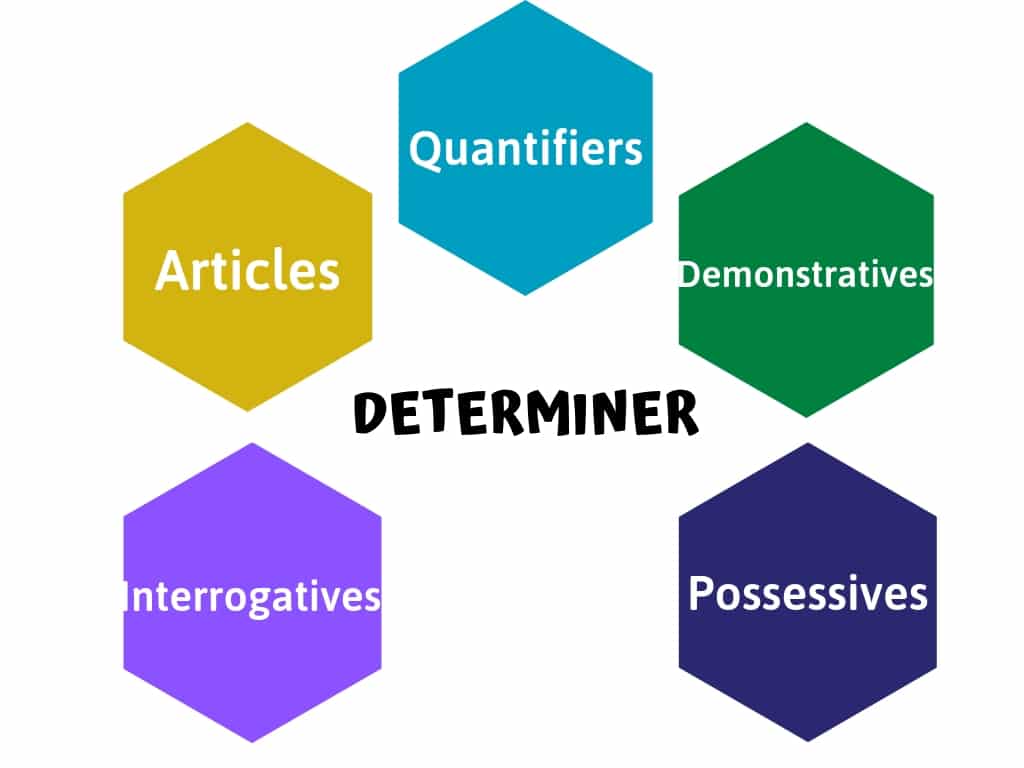Determiners in English Grammar with Examples [PDF]
Hello readers, in this grammar lesson we are going to learn the Determiners in English Grammar, with their types also I will give you some relatable example for your better understanding.To download the lesson in PDF format, please find the downloadable link attached below in the article.

Definition of Determiners:
A determiner is a general term for the words or a group of words that appear before a noun or a noun phrase. They’re meant to describe the noun or noun phrase by either specifying, identifying or quantifying it.
Also referred to as prenominal modifiers, determiners are commonly placed before a noun and their function is to offer some valuable insight about the specific nature of the noun in question.
Keep in mind that several determiners can be used all at once to tell us more about the noun or phrasal noun [External Link] that follows them. Which is to say, you’re NOT just limited to using one determiner at a time when describing a noun.
The difference between a Determiner and an Adjective
An adjective also comes before a noun and they’re also meant to describe it, not any different from a determiner. So, does that mean they’re one and the same thing?
The answer is NO.
The two terms may relate to each other on the ground that they both modify a noun or noun phrase [External Link]. However, when you look at them more keenly, you’ll notice that a determiner is meant to modify a noun by introducing it to the targeted audience, while an adjective modifies it by offering further details about it.
Another difference worth noting is that while adjectives can be graded, determiners, on the other hand, cannot. In other words, it’s possible to express adjectives in varying intensities, while the same cannot be done to a determiner.
For instance, you can describe the size of an object as either big, bigger or the biggest of them all. But the same cannot be done to a determiner. In short, you can’t possibly add an ‘er’ or ‘est’ to intensify a determiner.
Furthermore, while you can do away with adjectives without making any grammatical error, determiners are indispensable or the necessary part of a sentence and doing away with them means making a grave grammatical mistake.
Types of Determiners
Determiners come in various shapes and forms, with each one of them serving a different function.
The different types include articles, demonstratives, quantifiers, interrogatives, and possessives.
Articles
Only three articles exist – and that is ‘the’, ‘a’, and ‘an’. The article ‘the’ is the definite article, and that’s because it identifies a particular noun. In other words, it’s more specific in nature and its function is to point out which noun, in particular, is being referred to.
The other two functions on the other hand ‘a’ and ‘an’ are referred to as indefinite articles, and that’s because they’re more random in nature and don’t actually point out to one particular noun, but a class of them.
For example,
- She’s an engineer.
- His kid is a boy.
- Pick a friend.
- She’s the chosen one.
- Canada is one of the most visited countries in the world.
Quantifiers
Quantifiers inform us about the quantity or amount of the underlying noun. They’re basically meant to answer the question “how much?” or “how many?”
Examples of quantifiers include a little, a few, most, some, much, and any to name a few.
Examples in a sentence:
- How many students attend your class?
- How much money do you have?
- Only a little milk is left.
Demonstratives
As the name suggests, demonstratives are meant to point to a particular noun. They’re also used to indicate the position or location of a noun from the speaker’s point of view.
Examples of demonstratives include this, that, these and those.
The demonstrative ‘this’ is used to refer to a singular noun [External Link] that’s near the speaker while ‘these’ refers to items in plural that are near the speaker.
The demonstrative ‘that’, on the other hand, is used to refer to a singular noun that’s further away from the speaker, while ‘those’ refers to plural nouns that are further away from the speaker.
Examples in a Sentence:
- This is my jacket.
- These are our cups.
- That is my uncle.
- Those are our aunts.
Possessives
These ones express possession or ownership. They’re different from possessive pronouns [External Link] in the sense that they can’t stand alone. For instance, it’s grammatically correct to say “this cup is mine”, and NOT “this cup is my”. In which case, ‘mine’ is possessive pronoun while ‘my’ is a possessive determiner.
Examples include my, our, his, her, their.
Examples in a Sentence:
- This is my girlfriend.
- This is our house.
- She used to be his friend.
- This is their oranges.
Interrogatives
As you could have guessed, interrogatives are meant to ask questions. Examples include what, whose, and which.
Examples in a sentence:
- Whose T-shirt is this?
- What time are you leaving?
- Which gift item would you prefer picking for you dad?
This is the complete lesson on determiners in English Grammar, I hope you liked this lesson, if so then feel free to share this stuff with your friends.
References [External Links]:
- Determiners ( the, my, some, this ) – English Grammar Today
- Articles, Determiners, and Quantifiers – Guide to Grammar